All good things come with a price, don’t they?
If you enjoy cooking and spending time in the kitchen, the spills, splatters, and grease will eventually accumulate, and a good cleaning session will be necessary – one that’s a bit more thorough than the usual quick daily wipe-down of the stove, counters, and tabletops.
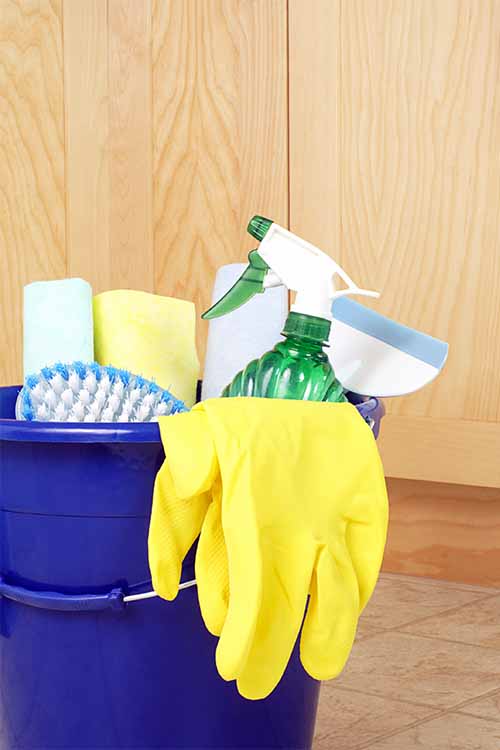
There’s no doubt that scrubbing the kitchen cupboards and cabinets can be a big task. So we’ve compiled the top tips for tackling this chore for the best possible results – in as little time and with as little effort as possible!
In this post we’ll cover how to clean some of the most common materials, like natural and painted wood, laminate, metal, and glass. We’ve also got the best cleaning method for tackling the worst in terms of accumulated kitchen grunge – the hidden tops of cupboards. And we’ll also share also a couple of foolproof methods to disinfect cupboard and drawer interiors, to keep your kitchen safe and sanitary.
A Little Dusting Goes a Long Way
What’s one very simple task that can minimize the frequency with which an intensive spring cleaning is needed?
Dusting.
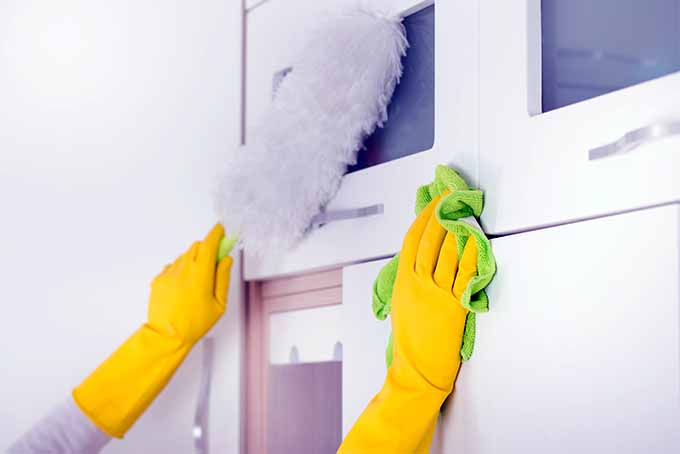
It may seem a bit counterintuitive to dust vertical surfaces, but dust will accumulate on cupboard exteriors – particularly if a lot of frying is done in your kitchen. Fine particles of oil will settle on all surfaces, including vertical ones, acting like a magnet to attract dust.
Regular dusting with a lint-free cloth or duster helps to prevent this combination of oil and dust from forming that sticky, hard-to-remove residue – which, when left undisturbed, attracts even more dust!
Start Simple
Most of the spots and smears that appear on cupboard exteriors on a daily basis can be handled simply with a soft cloth and warm, soapy water.
But for tough stains and built-up accumulations of grease and grime, a bit of extra elbow grease is required.
Here’s what you need to do:
- To wash with soap and water, use a clean, soft cloth and a mild detergent – Dawn or Ivory are both good options. Soak and wring out the cloth, then wipe down all surfaces, paying particular attention to handles, hinges, and any surface ridges that form design details.
- Rinse the doors and sideboards promptly with a soft cloth and clear, warm water, then wipe up the remaining moisture with another dry, soft cloth.
- For tough, sticky grease, a solution of white vinegar and hot water is an inexpensive and natural solution that produces very good results. Mix up a solution of one cup vinegar to two cups hot water. Soak a clean cloth in the solution, then wring out most of the moisture and wipe down your greasy cabinets. Dry with a soft cloth.
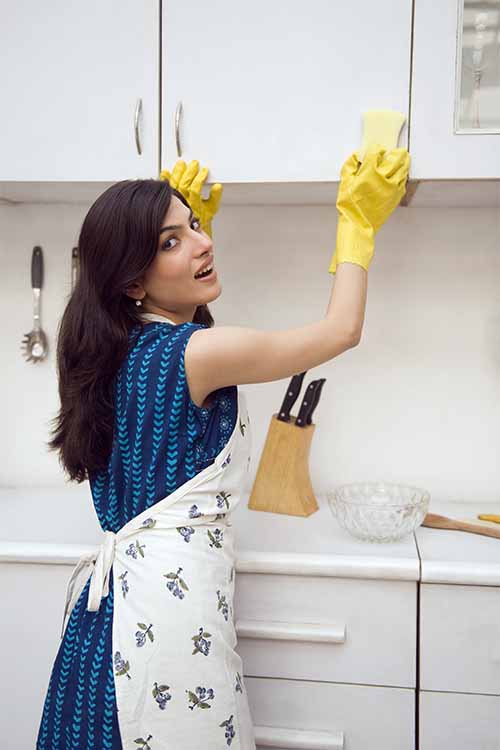
- If any sticky spots remain, dampen your wet cloth with undiluted white vinegar, and give it another wipe-down, applying a bit more pressure if needed. Rinse with clear water, and dry with a soft cloth.
- For really obstinate grease and grime, make a paste of white vinegar and baking soda – but test this on the inside of the cupboard first, to ensure it won’t mar the finish. Rinse your cloth with warm water, wring out the excess moisture, and pick up some of the paste. Dab it on wherever it’s needed and allow it to sit and work for a few minutes. Rub gently with a damp cloth or the textured side of a sponge to lift the grime, or use a soft-bristled brush, then rinse with clear water and dry with a clean cloth.
Avoid using anything that will scratch or dull the surface of your cupboard and cabinet finishes. This includes strong detergents, abrasive cleaners, scouring pads, and harsh dirt-cutting chemicals.
Warm & Wonderful Wood
Natural wood cabinets have a beautiful, warm appeal. And they’re not actually any more difficult to wash than other finishes. Most wood finishes can be cleaned in the same manner, without the need for expensive specialty products.
General purpose oil and soap cleaners like Murphy’s Oil Soap will cut through grease and stains on wood cupboards, but they also tend leave a sticky residue behind – which forms a natural trap for dust.
When wood becomes hard to clean, this is usually because the finish has become damaged to the point where water can seep through to the wood itself. And if the finish is cracked or peeling, refinishing may be what’s needed, rather than just a good washing.

Some of the challenges the finishes on wood cupboards face are the result of a few factors – with light, oxidization, and moisture being the most common problems.
While there’s little one can do to reduce the damage caused by light and oxidization, kitchen moisture can often be minimized.
First, avoid placing steam-producing appliances directly under wood cupboards. After an extended period of time, they will literally steam-clean the finish right off of the wood.
Locate drip coffee makers and electric kettles in spots where they won’t be billowing steam onto wood that’s overhead. And if moisture accumulates on a wood surface after running the dishwasher, wipe it down promptly with a dry cloth.
Whether your wood cabinets have a lacquer finish, epoxy, or a conversion varnish, all of them can be cleaned in the following manner.
And remember to dust every week or two, to extend the time that you can allow between more extensive scrubbings.
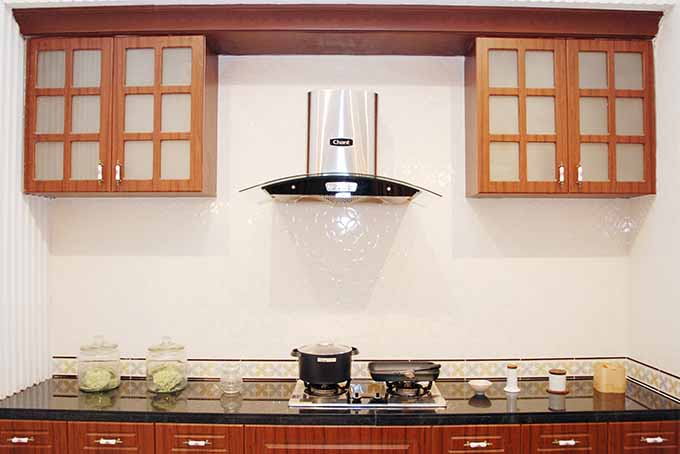
- For regular washing, use a soft sponge or cloth with a solution of warm, soapy water using a mild detergent, such as Dawn or Ivory. Rinse promptly with clear water, then dry with a soft cloth.
- For tough, sticky grease, a solution of 1 cup white vinegar and 2 cups hot water will work. Rub it in with a sponge, and dry with a soft cloth.
- If any sticky spots remain, dampen your wet cloth with undiluted white vinegar, or make a paste of baking soda and water. Rub this in gently with a sponge, then rinse with clear water and dry promptly.
- For layers of accumulated grease and grime, you may need to go with a natural citrus cleaner, such as lemon or orange oil. Select one that has a high percentage of d-Limonene around 90-100%, such as pure orange oil concentrate. Follow the manufacturer’s directions, and make sure to rinse well afterwards.
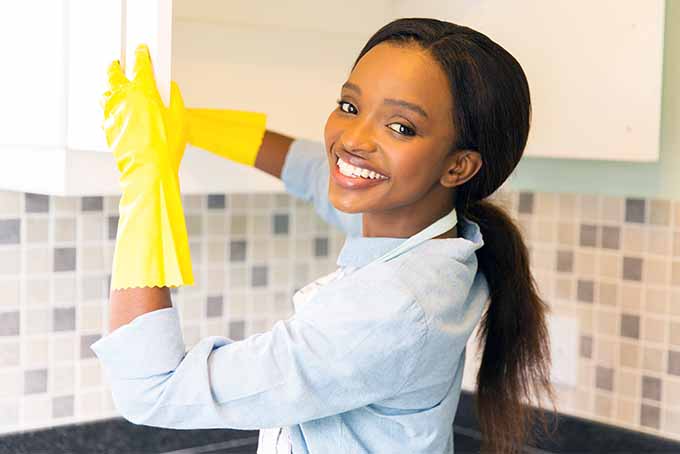
Limonene is a naturally occurring oil in the family of chemicals known as terpenes. It’s found in abundance in the peels of citrus including oranges, lemons, limes, and grapefruit. Its name is derived from the lemon, but d-limonene smells strongly of oranges.
A natural solvent, it’s particularly good at cutting grease. And as an all-purpose cleaner – non-carcinogenic, non-flammable, non-toxic and biodegradable – it outperforms many harsh solvents in terms of cleaning power, as is shown in this interesting data sheet that compares the relative strength of d-limonene to industrial solvents.
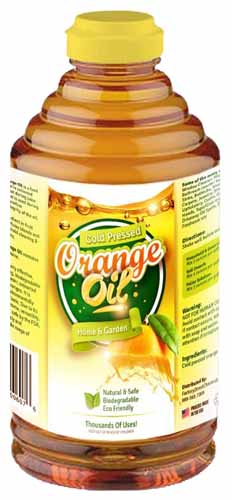
Pure Cold Pressed Orange Oil Concentrate available on Amazon
It has some pretty substantial credentials as a health-promoting compound as well. With its anti-inflammatory, anti-cancer, and other health-assisting properties, d-limonene also makes a noteworthy contribution to health and clinical applications.
As a little aside, orange oil with d-Limonene is an amazing biodegradable and natural cleaner.
When I worked in the movie biz, it was the only product that would actually lift and remove grease-based pancake makeup and reel blood from costume pieces – the two toughest stains for the wardrobe department. And, cleaning aside, it’s the only product I’ve ever found that effectively prevents deer from grazing in the garden like its Bambi’s salad bar!
As always, avoid using strong detergents, abrasive cleaners, scouring pads, or harsh dirt-cutting chemicals on wood finishes, or anything that will scratch, dull, or lift the finish.
A regular application of a good quality paste wax once or twice a year, or the occasional buffing with furniture polish after washing, will add a lustrous patina to wood cabinets and help to retain the finish as well.
To apply paste wax, use a clean, soft cloth to apply a thin layer of wax in small segments, using a circular motion. After applying the wax, it needs time to dry before buffing with a soft cloth.
Three important points to remember about waxing are:
1. Apply a thin coat. If a thick coat is put on, it won’t dry evenly and may leave a spotty sheen.
2. Allow the wax enough time to dry before buffing.
3. If using a paste wax with toluene (a solvent that keeps the wax soft), always ensure more-than-adequate ventilation. Open the windows and doors and turn on a large fan to push the fumes outdoors, as toluene fumes are very toxic.
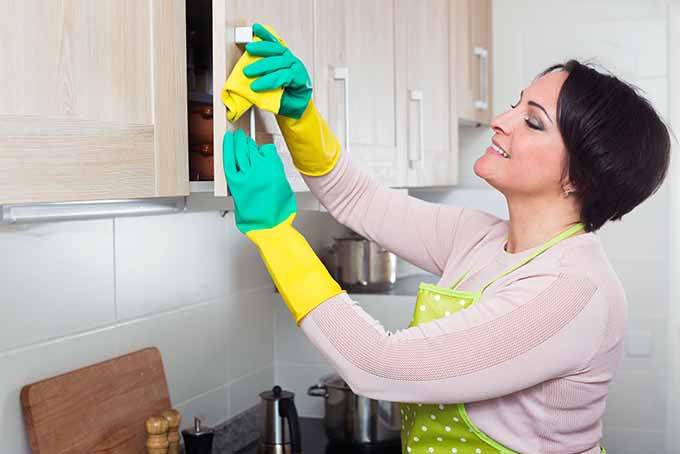
Better yet, choose a toluene-free option that uses mineral spirits instead – they’ll perform the same way, they just need a bit longer to dry. Briwax is a good quality paste wax used by professional cabinet makers and furniture restorers, and they make a toluene-free version as well.
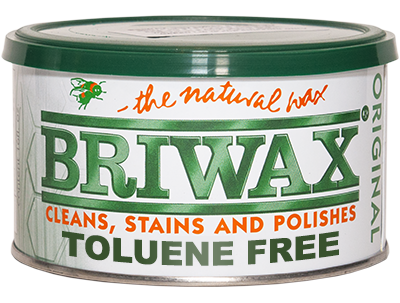
Briwax – Clear – Toluene Free Furniture Wax available on Amazon
Besides the clear version shown above, both the original formula and the toluene-free version are available in lots of different wood tones.
As far as “oiling” wood cupboards is concerned, most models manufactured for today’s kitchens will rarely have a true oil finish. This type of finish is found primarily on antique cabinets, or in the case of special orders, where a reproduction or antique finish is intentionally created. As such, the application of oils to moisturize wood is only needed for these specialty items.
It’s likely that the only wood pieces in your kitchen that require oiling for care and maintenance are wood cutting boards, salad bowls, or mortars and pestles.
Get more information on cleaning and oiling wooden cutting boards and chopping blocks now.
Pretty Painted Surfaces
Cabinets coated with an oil-based paint are more durable and wash up more easily than those painted with latex, or so-called “milk” or “chalk” paints. For oil painted surfaces, using a soft nylon brush can help to loosen stubborn dirt, but don’t use these on latex or chalk paints, as the scrubbing required may result in the paint lifting or peeling.
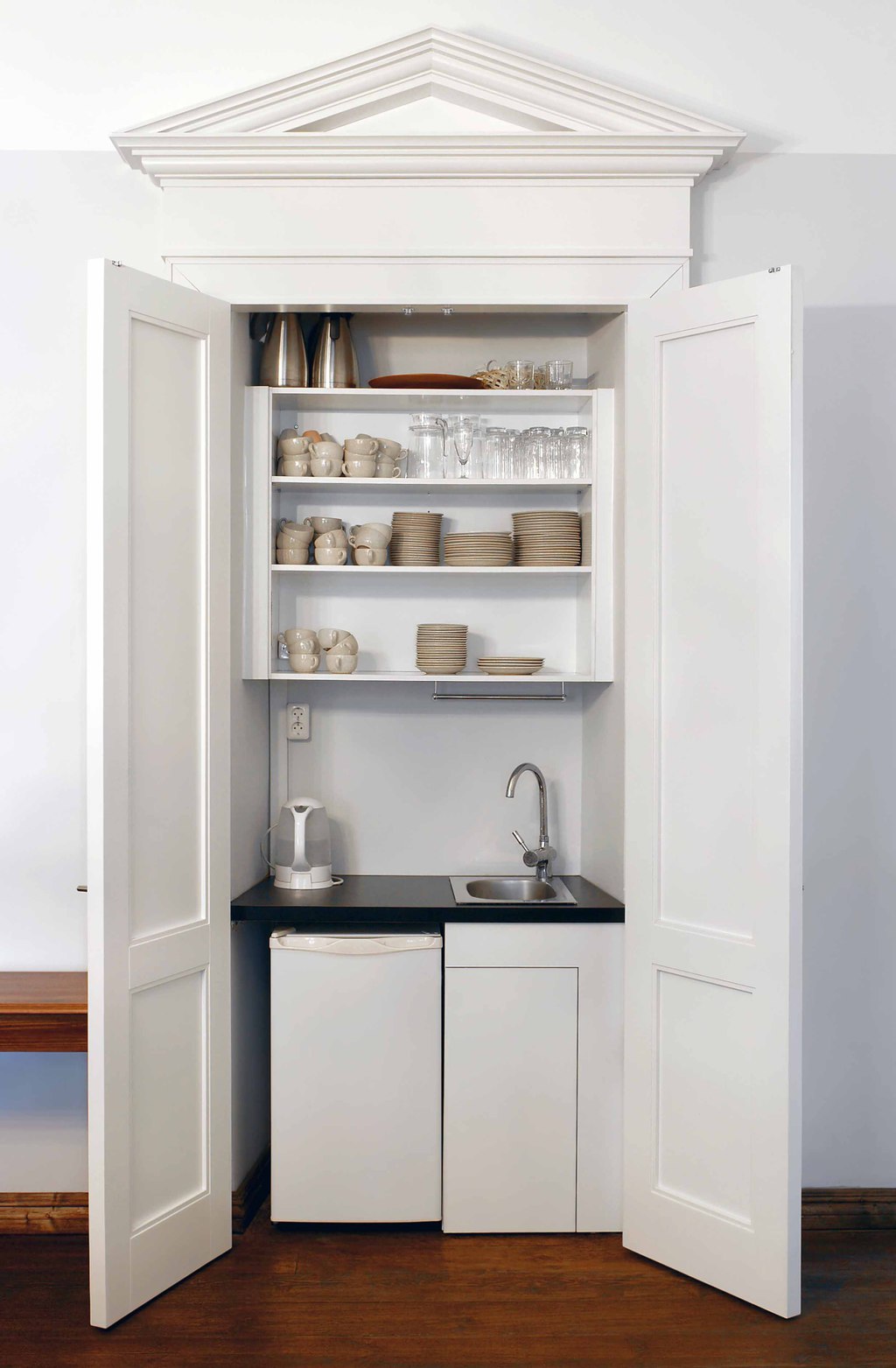
- To wash down painted cupboards, start with a mixture of one tablespoon of mild liquid dish detergent with one gallon of warm water. Immerse a soft sponge in the water, then squeeze out the excess until just damp. Scrub the dirtiest parts first, then wipe down the remaining surfaces.
- Use a soft toothbrush to target hinges, corners, and hard to reach spots, but be sure that you don’t use anything more abrasive than a soft brush.
- Vinegar and hot water will work on tough-to-clean painted surfaces, as will a paste of vinegar and baking soda.
- Oil-painted cabinets can also take a scrubbing with ammonia and hot water, but remember to open up the windows when using ammonia and avoid breathing in the fumes. Rinse with clear water and wipe dry when finished.
- Don’t allow your painted cupboard surfaces to air dry, as this will leave water spots – instead, always wipe them down thoroughly to dry.
- After washing, a thin application of a clear paste wax will help to protect painted cupboards from everyday stains, splatters, dust, and light scratches as well. Use a good quality paste wax, preferably one that’s toluene-free, to help seal and protect oil, latex, and chalk paint surfaces.
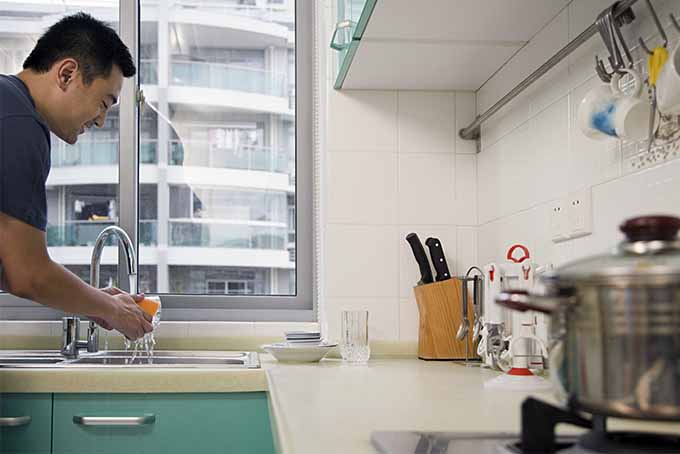
Avoid using liquid waxes on kitchen cabinets that are painted, as they usually contain oils that can react adversely with the paint. Citrus oils should also be avoided.
As with all cabinets, avoid using harsh detergents, abrasive cleaners, or metal scouring pads on painted surfaces, as they can scratch, dull, or mar the finish.
Long-living Laminate
Laminate surfaces offer a tough, durable finish that’s easy to clean and maintains their good looks, even in kitchens that receive a lot of abuse – like the beatings that come from kids, pets, and high-temperature cooking!
- Keep laminate looking good and reduce the frequency of washing with regular dusting.
- Clean laminate surfaces with a solution of mild dish soap and warm water, rinse with clear water, and wipe dry with a soft cloth.
- Use a hot water and white vinegar solution, or a vinegar and baking soda paste for tougher chores.
- Grease can usually be dissolved with undiluted white vinegar. Spray on full strength vinegar with a spray bottle and allow it to work for about five minutes. Use the finest mist setting on the sprayer to prevent dripping, and mist several times if needed. Wipe off the vinegar and grease with a soft cloth and hot, clear water.
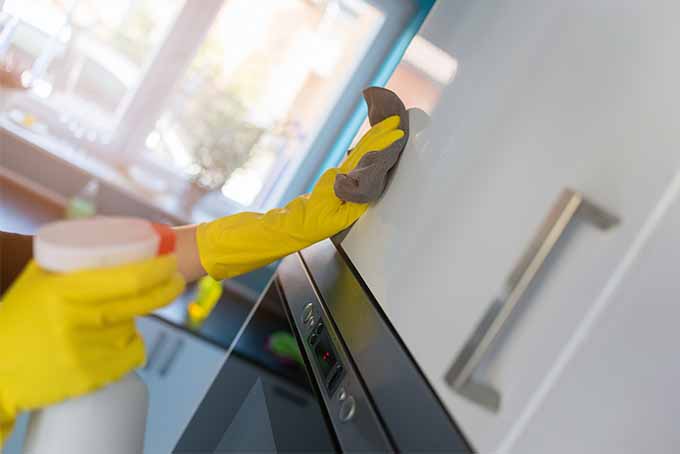
- The seams of laminate cabinets need a bit of extra attention, as they can trap grease and debris – use a soft nylon brush or toothbrush in these areas to loosen and lift dirt.
- Ensure that the seams are dried thoroughly as well, as the interior particle board can swell if they absorb too much liquid.
- For stains such as coffee, tea, grape juice, and cranberry juice, try a paste of baking soda and water, or baking soda and lemon juice. Dab up some paste with a soft cloth and cover the stain. Allow it to work for a few minutes, then rub gently with a soft, damp sponge to lift the marks.
- Or use a citrus-based cleaner with d-Limonene to remove stains. Apply a mix of one part citrus oil and one part water, and rub into the surface with a sponge. Allow it to emulsify for a few minutes, then rub gently with the scrubby side of a sponge. Wipe up and rinse with clear water.
Don’t use scouring pads or abrasive cleaners on laminate either, as they’ll dull and scratch the finish.
Metal Cabinets
Metal cabinets generally come with a painted enamel finish, so washing is done in the same manner as for other painted cabinets.
- Mix one part gentle liquid dish soap with one part warm water, and use a soft sponge to wipe down the surfaces.
- If washing with warm, soapy water and a soft sponge doesn’t remove all of the spots on your metal cabinets, use rubbing alcohol to wipe away grime and grease. Apply a small amount to a soft cloth and rub in a circular motion until the dirt is lifted.
- Erase any rust spots by gently rubbing with extra-fine steel wool. Be very careful with this, so as not to scratch the metal finish.
- Rinse away the soap and rubbing alcohol with clean water, and ensure that it dries completely to avoid rust. Use a blow dryer on any bare or sanded areas where rust has been lifted, hinges, or joined corners to completely remove any water residue.
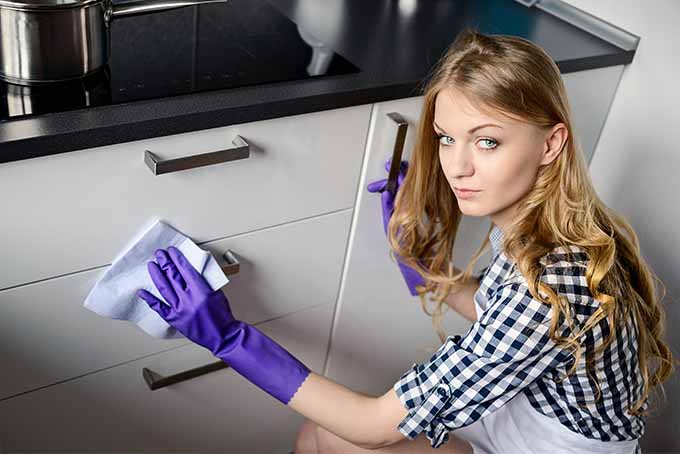
- And as an optional finishing step, apply a thin layer of good quality car wax over the entire surface of the cabinet for a lustrous glow – but don’t use the wax on any shelves that will be in contact with foodstuffs. And open the windows to provide adequate ventilation if you do use an automotive paste wax. While it won’t result in any chronic health effects, persistent inhalation of the fumes can cause irritation.
- If you’re not planning to repaint the entire cabinet, touch up areas where rust spots have been removed with paint that’s designed for metal surfaces. And If you can’t find a color match at the paint or hardware store, check your local auto body shop – they’ll often have a great selection of colors in small touch-up sizes.
Gorgeous Glass Doors
Glass cabinet and cupboard doors can be cleaned the same way as other glass household surfaces.
- For spills, dried-on foods, and daily grime, wipe with warm, soapy water on a soft sponge, then rinse with clear water.
- For a streak-free finish, use a solution of 50% distilled white vinegar and 50% water, or a commercial glass cleaner with ammonia.
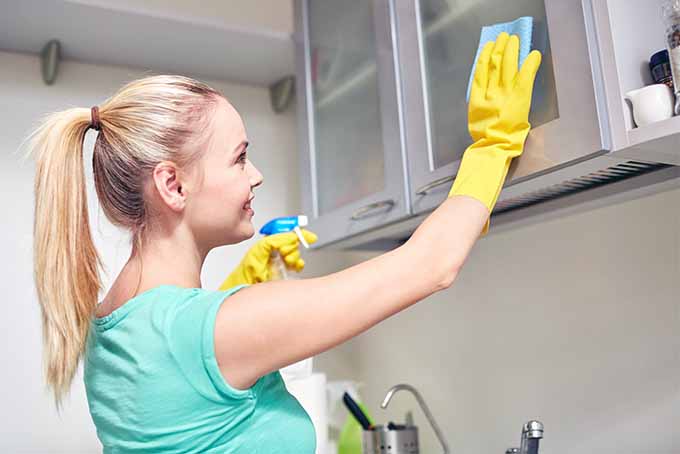
- For mounted glass within a wood frame, take care not to damage the finish of the door and cabinet parts with spray cleaner – wipe the frame down promptly if overspray occurs.
- If the glass doors have wooden mullions – the decorative division elements – spraying directly onto the glass can cause seepage into areas behind the mullions, potentially leading to discoloration of the wood. Rather than spraying your cleaner directly onto the glass, spray a small amount onto a soft cloth or lint-free paper towel instead, then wipe the glass with the cloth. Dry promptly with a soft, dry cloth or paper towels.
Disinfecting Cupboard & Cabinet Interiors
Like cleaning, disinfecting kitchen cabinets and cupboards is one of those tasks that needs to be done a regular basis.
To ensure that the job gets done properly, all the tough-to-reach corners and awkward spots need to be addressed, to ensure that no germs or bacteria remain.
Of course, this does take some time and effort. But for cupboards that hold foodstuffs, the effort is well worth the results, as it will keep mold and mildew from forming, helps to kill germs, and keeps insects at bay as well.
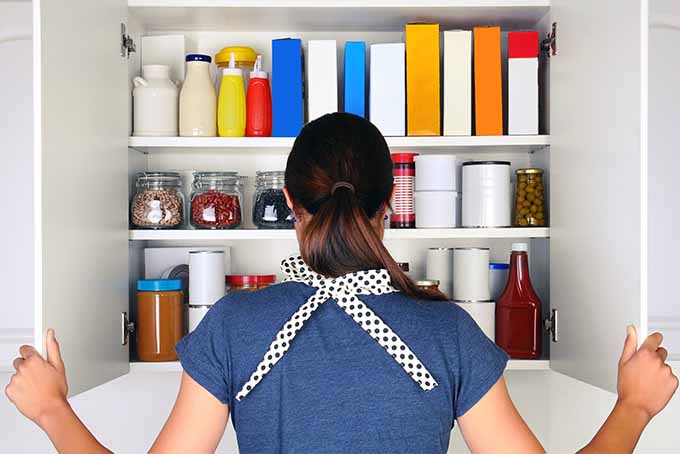
Bleach – Decidedly Disinfectant
One of the best ingredients for an intensive disinfecting of the kitchen is household bleach.
- Mix to a ratio of 1 part unscented bleach to 9 parts water. When handling bleach, always wear rubber gloves, and open the windows or turn the vent fan on to ensure that the kitchen is well ventilated.
- First wash with warm, soapy water, then rinse with clear water. Apply the bleach solution liberally with a clean rag, and rub it over the shelves and interior walls. Soak and wring out the rag frequently to ensure full disinfectant coverage.
- When you’ve finished applying the bleach solution, use fresh, clear water and a clean cloth to rinse the shelves and walls. Soak and wring out your cloth often, then wipe up any excess water with a dry cloth or paper towels.
Allow all surfaces to dry thoroughly before restocking with dishes or foodstuffs.
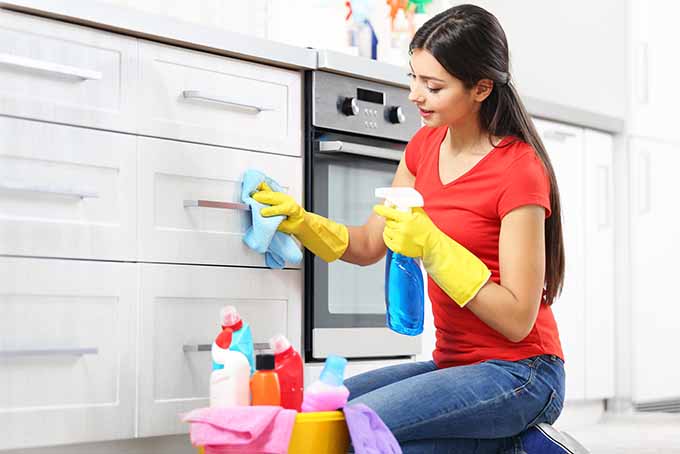
Tackling Tight Edges
The toughest spots to scrub inside your cabinets are the places where the edges of the shelves meet the cabinet walls, and in the corners. A cloth or sponge won’t usually be able to make full contact with these tricky areas for cleaning and disinfection.
To get right into these tight angles, use a toothbrush dipped into the bleach solution described above, and let the bristles work into the edges. For the corners, dip a Q-tip into the solution to remove any lurking bits and pieces.
Rinse with clear water and dry with a clean cloth before replacing your kitchen goods.
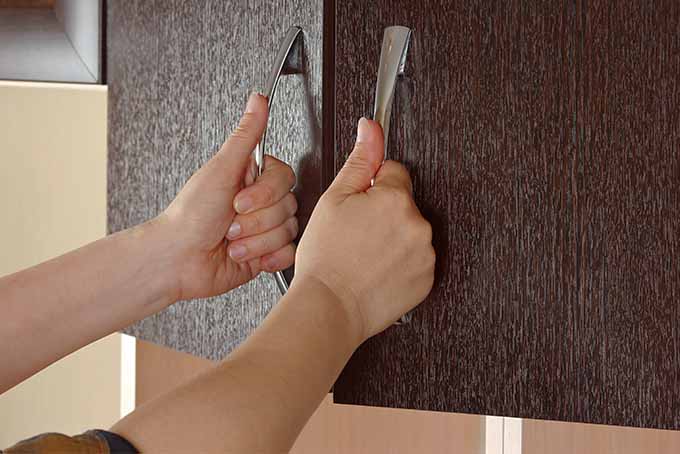
Don’t forget: the outside of the cupboards needs to be disinfected as well, particularly in the handle area. After washing, wipe down the exteriors with bleach solution, rinse, and dry.
When using a bleach solution, always test a small, inconspicuous area to ensure that it won’t cause damage or discoloration.
Don’t Forget the Drawers
Drawers should be cleaned and disinfected periodically as well.
To do this, remove the drawers from the runners, empty them of all goods, and wash with warm, soapy water. Rinse with clear water and allow to drip dry upside down in the sink or on a dish rack to drain off any excess water.
Using the 1:9 ratio of bleach to water described above, liberally soak each drawer with the solution. Use a toothbrush to get into the edges, and a moistened Q-tip to get the gunk out of the corners.
Rinse with clear water, wipe up the excess water with a sponge, and allow to air dry upside down before replacing.
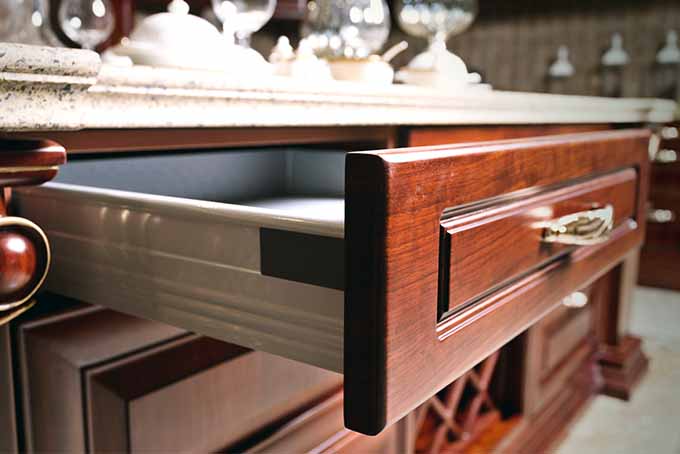
Once your drawers, cabinets, and cupboards have been washed and disinfected, an excellent option to help keep the interiors fresh and clean longer is to line them with shelf paper.
Cut to size and set in place before returning dishes, cutlery, or foodstuffs, but do remember to replace the paper on a regular basis when wiping your cabinets down.
While sticky-backed contact paper for lining shelves is a great idea in principle, in truth, the glue that provides its tacky surface also attracts (and glues) dirt in place. And the residue it leaves behind can be difficult to remove as well. For the easiest cleaning and paper changing, stick with non-sticky paper!
Bleach Alternatives
If you have a sensitivity to bleach or prefer not to use it, here are a few other options to consider:
Cleaning:
- Wipe down the inside of cupboards and drawers with warm, soapy water or white vinegar diluted with warm water – about one part vinegar to two parts warm water. Rinse and dry.
Disinfecting:
- To disinfect the interiors of cabinets and drawers, mix a solution of 1/4 cup white or apple cider vinegar with 1/4 cup hydrogen peroxide plus 1 cup of water.
- Add a couple of drops of your favorite essential oil if desired – the fragrance will remain after the scent of the vinegar leaves.
- Pour into a spray bottle and mist empty interiors lightly. Allow to air dry before putting dishes and foodstuffs back.
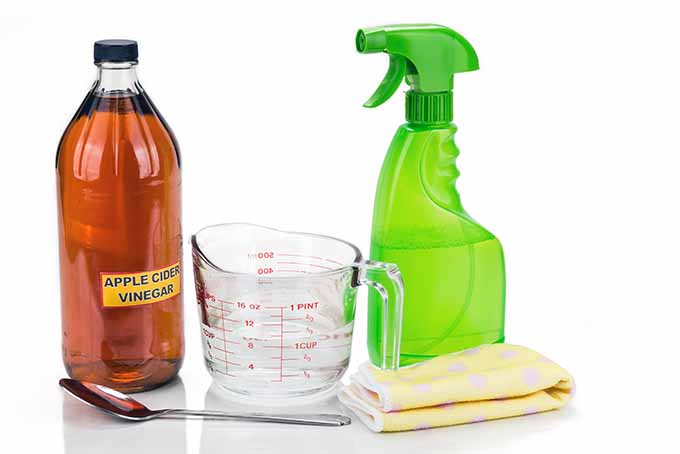
Tea tree oil is another natural disinfectant that will kill bacteria.
- In a spray bottle, combine 2 cups water with 1/2 teaspoon of liquid soap, 2 tablespoons white vinegar and 20-25 drops of tea tree oil.
- Shake well to mix, and apply as directed above.
Horizontal Cupboard Tops
The tops of kitchen cupboards are where the really nasty, thick, greasy crud lives. This is one of those “out of sight, out of mind” spots that doesn’t get cleaned nearly as frequently as the eye-level smears.
Since the tops of these cabinets are often of an unfinished nature, some tools and heavy-duty cleaners can be used without having to worry about wrecking the finish.
- The easiest way to cut through this mess is with powdered dishwasher detergent. You’ll want to wear rubber gloves for this task.
- Soak an old rag in hot water and lay down a layer of water on the cabinet top – not swimming wet, but wetter than damp. Next, sprinkle on a generous layer of detergent. Add a bit more water if needed to activate the detergent, and let it stand for five minutes.

- If the layer of grime is really thick, use a wide metal putty knife to “plow” through the worst of the grease as it loosens, then mop it up with your rag.
- Once the worst is gone, sprinkle some detergent directly onto your wet rag and scrub in small sections. Add more detergent as needed, scrub, and repeat until all of your cabinet tops are fresh and clean. If you need something more abrasive than a rag, use a nylon scrubber or Magic Eraser.
- Rinse with clear water, and dry with paper towels.
Final Thoughts
That pretty much covers our look at washing and disinfecting kitchen cupboards and cabinets.
While this might not be anyone’s favorite task (well, maybe it’s someone’s – this is the internet, after all!), those sparkling clean, germ-free surfaces provide a great feeling of satisfaction once you’re finished. Your cupboards not only look great after a thorough scrub-down, they also bring the peace of mind that cleanliness provides.
An excellent finishing touch to your kitchen cleaning spree? Freshening the air with these all-natural air-freshening solutions.
While you’re in a cleaning mode, check out some of our other guides for clever cleaning and organizing tips:
- The Natural Cleaning Power of Lemon
- 5 Quick Ways to Organize a “Junk” Drawer
- Top Techniques to Clean Large Kitchen Appliances
© Ask the Experts, LLC. ALL RIGHTS RESERVED. See our TOS for more details. Originally published on July 24, 2016. Last updated on September 27, 2021.
About Lorna Kring
Recently retired as a costume specialist in the TV and film industry, Lorna now enjoys blogging on contemporary lifestyle themes. A bit daft about the garden, she’s particularly obsessed with organic tomatoes and herbs, and delights in breaking bread with family and friends.




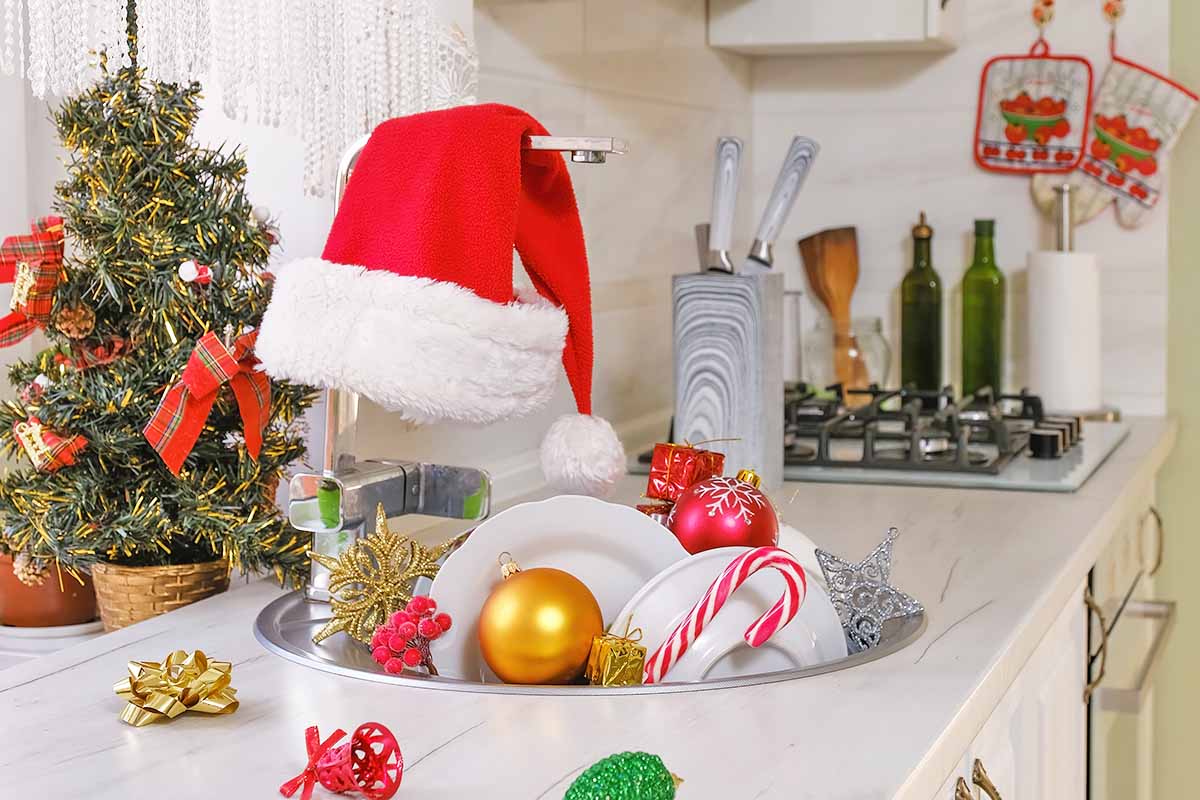

Since I’m the one that has to clean the kitchen, I can always use more cleaning tips. Grease can be a real chore to clean up after a while of build up. I had no idea that its the dust particles that make the grease hard to clean. I really want to get into cleaning with vinegar because bleach smells very strong to me. The toothbrush trick for cleaning in those tight spots is something I must try as well. I have been so upset trying to use a cloth to clean the joints only for it to not work.
Glad you liked the tips Jasmine, and thanks for your thoughts!
This is a very timely reminder. At this time of year, certainly in my larder, stocks from last year are low and the major pickling, canning, bottling and jam- making hasn’t got into full swing yet, so now is the ideal time to eject the spiders and clean all the sufaces and crevices. I’ve been wine-making this week, and the wine store has had a thorough clean, so at least I feel as tough I’ve made a start.
Good point Sue – when the pantry’s almost empty certainly makes cleaning easier. And spiders should be outside for the summer anyways!
A good clean kitchen is so important, and I prefer clear up any spillages quickly so there is no build up, and soak as long as possible. My mother is allergic to bleach so we have switched to white vinegar which works well, but does take a few applications.
I also use old sponges for the floors or to do the doors of the cooker or fridges, and then throw them away. Don’t forget the handles, as I always use a paper towels to go around the edges.
Some good tips Bella, thanks for sharing.
That’s a really great article. Personally, I never let the grime build up. I am borderline OCD, and I do sometimes think that I spend way too much of my time in the kitchen cleaning rather than cooking.
But at least when you do cook, you’ve got a clean kitchen to do it in! Thanks for your thoughts NormaD.
Very informative article, and also a real motivator to spend a bit more time on my cupboard tops. The out of sight , out of mind philosophy rings true for me.
Awesome you found some motivation atlmom5! Those tops are so easy to overlook…
How do I get rid of mice
I have white cabinets so they are always getting dirty. I find warm water often does the trick especially when something spills on them. However I’m also a big fan of method wood cleaner. It’s non toxic so I don’t mind using it in the kitchen. It also does a great job at getting tough grease and grime off. I think any wood cleaner will do the trick.
Thanks for sharing Kimmy, it’s great to find a non-toxic product that works!
This is an extremely helpful article. I was unaware that the dust was what made it difficult to remove the layer of grease. Since I am normally left to do most of the dusting in my house, this is a great inspiration to do more efficient cleaning. I feel as though this will give me a great starting place.
Yup, dust and oil do combine to make a sticky mess! Glad you found the post helpful Christina.
I think the ultimate guide should cover ‘getting someone else to do it’ – for me at least, ha! I really hate doing that job, even though I love how the kitchen looks and smells when I’ve finished!
Haha… Well, yes, hiring the professionals should be right at the top of the list! Good one uk!
When it comes to cleaning, I always help my mom because she’s a little big old and she really needs of some extra help for that kind of chore, therefore, I am the one who cleans the kitchen most of the time, I really like doing it because I definitely love seeing my house clean and that’s why I contribute to keep it as clean as possible. These are some really useful tips that I will definitely try the next time I run the cleaning process, thanks a lot for sharing this, appreciated!
It can be hard work for sure Casiox, but doesn’t it look great when it’s done?! Glad you found the tips helpful…
Thanks for this cleaning tips. I must agree with the apple cider vinegar and hydrogen peroxide as a cabinet cleaner. I already tried it once and I’m so satisfied with the results.
That’s great Andy! Thanks for sharing.
I loved reading your page and I wondered if you would be so kind as to give us some advice. We are buying a new kitchen and the shaker style door that we like is mdf with a laminate wrap, but it has a faux woodgrain. As it is a pale Dove Grey I am concerned that any dirt from fingers will get ingrained within the faux woodgrain. I haven’t seen this mentioned on your page, so I am wondering if I am worrying about nothing? Thank you.
Hi Maralin, I think you might be concerned about nothing… Although laminates can look like the real deal with a grain, they usually have a smooth surface that prevents grime from getting ingrained. Hope this helps!
Hi,
Could you please help me decide how to clean my kitchen cabinets? They’re a few years old but by mistake I applied cabinet stain which was provided for patch-ups. Thought it would all be evenly done but it left stain patches.
Thank you!
Hi Niah, wood stain is a tough one. It sounds as though you might have to finely sand the entire surface and re-apply the stain in one even coat. Good luck!
A good and clean kitchen is very important, and I prefer to clear up any spillages quickly so there is no buildup, and soak as long as possible. My mother is allergic to bleach so we have switched to white vinegar which works well, but it does take a few applications. Thank you for mentioning these amazing points.
Thanks Lisa, glad you enjoyed the article!
Quite some years ago, I painted my kitchen cupboards white (not a true white, something like ‘snow’ white). Anyway, they weren’t as white as my appliances, so 3 years ago, I had my cupboards professionally done in a pure white, high gloss melamine. Gorgeous.
However, the cupboards have yellowed now, after only 3 years (they are wiped down regularly, and I do a full on spring cleaning every year). I do smoke in my house, which is why I do such extensive cleaning regularly.
The original painting I did myself didn’t yellow. I’m disappointed that the professional paint job, with melamine paint, has yellowed. Having the cupboards repainted is an option of course.
But I was wondering if you have any suggestions for bringing these cupboards back to the brilliant white? Over the years, I’ve found the best product to remove nicotine stains is Fantastiq, which does a ‘fantastic’ job on all my walls, trim, doors, etc. It didn’t work on the kitchen cupboards though.
Sorry Beverly, from what I can tell, if the staining isn’t on the surface (that would come off with regular cleaning) you may have to go the repainting route – but it’s a bit of a process that involves sanding and sealing. Check out some of the online tutorials for complete instructions, and good luck!
I have brilliant white Formica units. All the units are still brilliant white, three are going a creamy colour. I have been in touch with the supplier who said he had not seen this before. He has refused to change them as he said he does not do these units anymore. It will cost thousands of pounds to replace all units – there are thirty units altogether. I have cleaned with most stuff on the market. What would you suggest? I am desperate. -MARGERY
Hi Margery – my first thoughts on the cause of your cabinets yellowing is sunlight. UV rays are a common fading/yellowing problem for paint and laminates – draperies, blinds, or window film will help to protect your cabinets from harmful UV light.
It could also be caused by heat from the stovetop/oven – are the three problem units close to your stove? If so, a heat-resistant paint might be a solution.
As for cleaning products, a good solution to remove yellowing is to mix up a solution of white vinegar (1 cup) with warm water (2 cups) and baking soda (1 tbsp.) – use a spray bottle to apply this fizzy mix and work in with the scrubby side of a nylon sponge, then rinse well with water.
Hope this helps!
I like that you suggested dusting your wooden cabinets every week or two to make sure that its finish will not become damaged due to dust residue. My husband and I are actually planning to install wooden bathroom cabinets. We want to make sure that our wooden cabinets will have the best condition to for years to come so we can save money on repairs. Since we want to prevent our wooden cabinets from looking old, we’ll do all your tips.
I have the real old porcelain white kitchen sink with the old white metal cabinets and they are filthy – just moved in. How can I clean them??
I REPAINTED MY BROWN CABINETS WITH POLYURETHANE TO ADD A SHINY FINISH AND THE VARNISH TURNED TO A LIGHTER COLOR AND APPEARED LIKE THE CABINETS HAD BEEN BLEACHED. I HAVE WASHED THE CABINETS WITH VINEGAR, BAKING SODA, AND WATER AND NOT CHANGES.
WHAT CAN I DO?
Ah, thank you for the tip to use tea tree oil to try to kill bacteria on your cabinet. I’m thinking of getting new cabinets installed in our home. I want to make sure that I can effectively care for these and maintain their longevity.
I have a corner lazy susan cupboard.
I can clean the lazy susan, BUT I would like to clean the walls floor etc., of the cupboard.
Is there a tool that is made to get into this space?
These corner space savers are common, so I think many of us face this cleaning challenge.
well here is a good one for you. I was handling red candles and obviously got some of the dye on my hands. without being aware I touched one of my cabinet doors and now there is a red fingerprint on my white MDF cabinet door. I am unsure of how to tackle this, I have used a soft Jude cloth which is what I normally use (its like a suede)
and tried baking soda paste, magic eraser (very gently as it can still be abrasive) vinegar and water .not sure what else to try without marring or dulling surface
Any suggestions ?
Pat
Oxy clean?
My kitchen cupboards are a light blonde wood but now have yellowed with age is there anything I can use to get rid of the yellowing to lighten them
Hi Theres, yes, your age-yellowed wood can be lightened.
It’s usually the top coat that has yellowed, such as varnish or wax.
Sealers and varnish are typically removed with a paint stripper then sanded to clean, smooth, and finish the surface.
If the finish is oil or wax, a lacquer thinner is used to strip down the layers, followed by sanding.
After stipping and sanding, you can apply a new topcoat for protection.
If you find the wood itself has yellowed, after removing the old top coat, use wood bleach (oxalic acid) to lighten the wood then apply a new topcoat.
Use the appropriate safety measure when handling strippers and oxalic acid (proper ventilation, safety goggles, gloves…) And I’d suggest watching some tutorials first – there’s plenty online to help you get the results you’d like.
Thanks for asking!